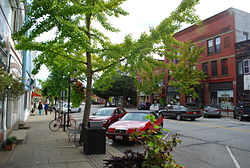Oberlin, Ohio
| Oberlin | |
|---|---|
| City | |
| City of Oberlin | |
 |
|
| Motto: "Live. Learn. Lead." | |
 Location of Oberlin, Ohio |
|
 Location of Oberlin in Lorain County |
|
| Coordinates: 41°17′18″N 82°13′0″W / 41.28833°N 82.21667°WCoordinates: 41°17′18″N 82°13′0″W / 41.28833°N 82.21667°W | |
| Country | |
| State |
|
| County |
|
| Government | |
| • Type | Council-manager |
| • City manager | Eric Norenberg |
| Area | |
| • Total | 4.96 sq mi (12.85 km2) |
| • Land | 4.92 sq mi (12.74 km2) |
| • Water | 0.04 sq mi (0.10 km2) |
| Elevation | 814 ft (248 m) |
| Population (2010) | |
| • Total | 8,286 |
| • Estimate (2012) | 8,300 |
| • Density | 1,684.1/sq mi (650.2/km2) |
| Time zone | Eastern (EST) (UTC-5) |
| • Summer (DST) | EDT (UTC-4) |
| ZIP code | 44074 |
| Area code(s) | 440 |
| FIPS code | 39-57834 |
| GNIS feature ID | 1049034 |
| Website | http://www.cityofoberlin.com/ |
Oberlin is a city in Lorain County, Ohio, United States, southwest of Cleveland. Oberlin is the home of Oberlin College, a liberal arts college and music conservatory with approximately 3,000 students.
The town is the birthplace of the Anti-Saloon League and the Hall-Héroult process, the process of reducing aluminum from its fluoride salts by electrolysis, which made industrial production of aluminum possible.
The population was 8,286 at the 2010 census.
Oberlin was founded in 1833 by two Presbyterian ministers, John Jay Shipherd and Philo P. Stewart. The pair had become friends while spending the summer of 1832 together in nearby Elyria and discovered a shared dissatisfaction with what they saw as the lack of strong Christian morals among the settlers of the American West. Their proposed solution was to create a religious community that would more closely adhere to Biblical commandments, along with a school for training Christian missionaries who would eventually spread throughout the American frontier. The two decided to name their community after Jean-Frédéric Oberlin (1740–1826), an Alsatian minister whose pedagogical achievements in a poor and remote area had greatly impressed and inspired them.
Shipherd and Stewart rode south from Elyria into the forests that covered the northern part of Ohio in search of a suitable location for their community. After a journey of approximately eight miles, they stopped to rest and pray in the shade of an elm tree along the forest, and agreed that this would be a good place to start their community. Legend has it that while they prayed, a hunter saw a family of bears climb down from a nearby tree. The bears saw the two men, but turned away without harming them. On hearing this story from the hunter, the two ministers took it to be a sign from God that they had selected the right place for their community and school.
...
Wikipedia
